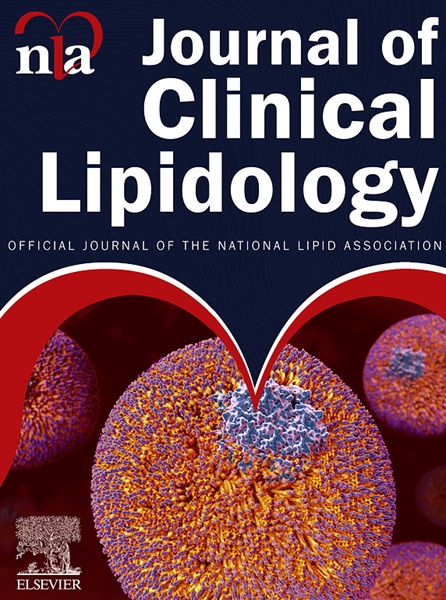Epidemiology and longitudinal course of chylomicronemia: Insights from NHANES and a large health care system
IF 3.6
3区 医学
Q2 PHARMACOLOGY & PHARMACY
引用次数: 0
Abstract
BACKGROUND
Chylomicronemia is characterized by fasting triglyceride (TG) ≥1000 mg/dL; its longitudinal course is not well studied.
METHODS
Using National Health and Nutrition Examination Survey (NHANES) data (1999-2018; n = 21,998), we determined chylomicronemia prevalence and temporal trend. Using Mayo Clinic data (4,524,506 TG measurements for 1,294,044 individuals), we studied the longitudinal course and ascertained persistent chylomicronemia (PC), defined as TG ≥1000 mg/dL in more than half the measurements for individuals with ≥3 measurements. We used logistic regression to assess factors associated with PC.
RESULTS
In NHANES, the prevalence of chylomicronemia was 0.20% overall, with higher prevalence in men (0.32%) and Hispanics (0.33%). Chylomicronemia prevalence declined from 0.34% in 1999-2004 to 0.11% in 2013-2018, while lipid-lowering pharmacotherapy use in chylomicronemia patients increased from 5.3% to 51.9%. In the Mayo Clinic data, 5618 individuals (0.43%) had at least 1 episode of chylomicronemia. Of these, 8.8% (390 of 4443 with ≥3 measurements) met the operational definition for PC. In individuals with TG <150 mg/dL, 1.3% had a diagnosis of acute pancreatitis, and 0.6% had chronic pancreatitis. Respective figures for individuals with nonpersistent chylomicronemia were 12.5% and 5.1%, and for individuals with PC were 26.2% and 11.5%. Younger age, Hispanic ethnicity, prior pancreatitis, and higher TG levels were associated with PC.
CONCLUSION
In the US, 1 in ∼500 adults has chylomicronemia and 1 in ∼5500 has PC. Individuals with PC have high occurrence of acute and chronic pancreatitis and may need more effective treatment.
乳糜微粒血症的流行病学和纵向病程:来自NHANES和大型卫生保健系统的见解。
背景:乳糜微粒血症的特征是空腹甘油三酯(TG)≥1000mg /dL;它的纵向走向还没有得到很好的研究。方法:使用1999-2018年国家健康与营养检查调查(NHANES)数据;N = 21,998),我们确定了乳糜微粒血症的患病率和时间趋势。利用梅奥诊所的数据(1,294,044人的4,524,506次TG测量),我们研究了纵向病程,并确定了持续性乳糜低血症(PC),在≥3次测量的个体中,超过一半的测量定义为TG≥1000 mg/dL。我们使用逻辑回归来评估与PC相关的因素。结果:在NHANES中,乳糜微粒血症的总体患病率为0.20%,其中男性(0.32%)和西班牙裔(0.33%)的患病率更高。乳糜微粒血症的患病率从1999-2004年的0.34%下降到2013-2018年的0.11%,而降脂药物治疗在乳糜微粒血症患者中的使用率从5.3%上升到51.9%。在梅奥诊所的数据中,5618人(0.43%)至少有一次乳糜微粒血症发作。其中,8.8%(4443例≥3次测量中的390例)符合PC的操作定义。结论:在美国,每~ 500名成年人中就有1人患有乳糜微粒血症,每~ 5500名成年人中有1人患有PC。PC患者急性和慢性胰腺炎发生率高,可能需要更有效的治疗。
本文章由计算机程序翻译,如有差异,请以英文原文为准。
求助全文
约1分钟内获得全文
求助全文
来源期刊
CiteScore
7.00
自引率
6.80%
发文量
209
审稿时长
49 days
期刊介绍:
Because the scope of clinical lipidology is broad, the topics addressed by the Journal are equally diverse. Typical articles explore lipidology as it is practiced in the treatment setting, recent developments in pharmacological research, reports of treatment and trials, case studies, the impact of lifestyle modification, and similar academic material of interest to the practitioner.
Sections of Journal of clinical lipidology will address pioneering studies and the clinicians who conduct them, case studies, ethical standards and conduct, professional guidance such as ATP and NCEP, editorial commentary, letters from readers, National Lipid Association (NLA) news and upcoming event information, as well as abstracts from the NLA annual scientific sessions and the scientific forums held by its chapters, when appropriate.

 求助内容:
求助内容: 应助结果提醒方式:
应助结果提醒方式:


